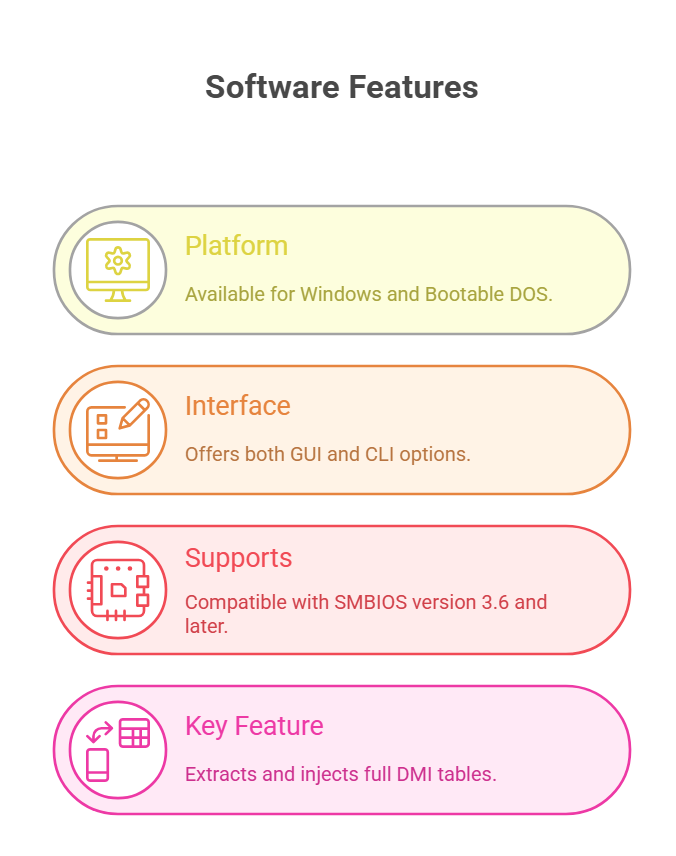Desktop management interface (DMI) is a standardized framework used by system administrators, firmware developers, and diagnostic software to access system information such as the motherboard model, BIOS version, CPU type, RAM configuration, and more. It’s part of the broader System Management BIOS (SMBIOS) spec, but DMI is the historical foundation for how most modern machines describe their hardware internally.
Why Does DMI Matter in 2025?
In 2025, with zero-trust infrastructure and real-time orchestration tools becoming mainstream, devices are expected to report their hardware characteristics accurately. If your machine has incorrect or corrupted DMI tables, it could mean:
- Incompatibility with remote management tools
- Non-compliant reporting in enterprise networks
- Licensing errors for OEM-bound software
- Failed BIOS/firmware updates
So if DMI is corrupted (or misconfigured during a hardware upgrade), it can cause more headaches than you’d expect.
How the Desktop Management Interface Works
The DMI stores information in a system-level format called SMBIOS tables. These tables include records like:
- Manufacturer Name
- Serial Number & UUID
- BIOS Version
- System Model
- Asset Tag
- Processor Info
- RAM slots used
- … and even Boot Order hints in some configurations
Operating systems such as Windows, Linux, and macOS access this DMI data regularly—especially during diagnostics, driver installations, and software registration tasks.
In enterprise networks, DMI data is critical for IT inventory & compliance audits.
“Spent 3 hours figuring out why our asset tags weren’t syncing—turns out the DMI on 15 new laptops was blank. Fixed it with AMI DMI Editor. Magic.” – IT Technician, via a private tech forum
What Is a Desktop Management Interface Editor?
A desktop management interface editor (or DMI editor) is a software tool that allows you to view and modify the values stored in your system’s DMI table. Depending on the OEM, BIOS brand (AMI, Phoenix, Insyde), or system manufacturer, this could be a command-line tool, GUI, or even a bootable utility.
These editors let you adjust entries like:
- System Manufacturer
- Product Name and SKU
- Serial Number
- BIOS strings
- Custom fields for asset tracking
Why Edit the DMI Table?
There are legitimate reasons to use a desktop management interface editor:
- Post-replacement motherboard fixes
If you’ve swapped out a motherboard, DMI values may show “To Be Filled By O.E.M.” or may not match invoices. - OEM Branding
Rebrand systems for resale or asset management with correct serials and tags. - Correct corrupted entries
BIOS flashes gone wrong? A DMI editor can often repair misreported specs. - Enable specific BIOS features
Some features only unlock if DMI matches expected strings (e.g., TPM activation, Windows activation).
Best Tools for DMI Editing in 2025
Here are the most trusted tools for DMI editing that are relevant and updated for modern machines:
AMI DMI Editor
If your system has an AMI BIOS (American Megatrends), this is the go-to.
- Platform: Windows + Bootable DOS versions available
- Interface: GUI & CLI
- Supports: SMBIOS v3.6+
- Key Feature: Can extract and inject full DMI tables
How to Get It:
Search for “AMI DMI Editor Download” from trusted support vendors or directly via BIOS toolkits offered by OEMs.

Phoenix DMI Editor (Tool Suite)
For older laptops or legacy systems, the Phoenix BIOS toolset often includes a safe and easy-to-use editor.
- Platform: Primarily DOS-based
- Interface: Text UI
- Note: Use carefully—many Phoenix systems can brick with incorrect edits.
DMIDecode for Linux
Not an editor per se, but essential for CLI-based system info review.
sudo dmidecodepulls readable BIOS/DMI data- Use it before & after edits to confirm success
HpDMI Tool (for specific HP systems)
HP and Lenovo systems often require proprietary DMI editors with digital signing checks. You must use OEM-recommended tools.
Real-Life Use Case for Editing the DMI
Let’s say you work for a managed IT service group and just replaced the motherboards on 60 business desktops due to a recall. Upon boot, your endpoint manager shows these as “Unknown Manufacturer, Model: Placeholder.”
Instead of issues stacking up, you batch script AMI DMI Editor across these systems. Correct Manufacturer, Model, Serial—restored in minutes.
Productivity saved. Compliance reports accurate. Your team thanks you.
Is It Safe to Use a DMI Editor?
Like BIOS flashing, DMI editing comes with risks. You’re modifying firmware-level tables that the system and OS rely on. Common mistakes include:
- Breaking Windows OEM activation
- Causing BIOS misbehavior
- Triggering anti-tamper flags in enterprise antivirus/MDM tools
Rule of thumb:
If you don’t back it up first, don’t change it.
Use the “Save DMI” or “Export Configuration” feature before making any modifications. Most DMI editors offer this as a default function.
Where to Safely Find a DMI Editor Download
Be cautious. “DMI editor download” is a high-risk search term for malware-toting websites.
Safe sources include:
- Official BIOS Vendors (AMI, Phoenix)
- OEM Support Portals (HP, Dell, Lenovo)
- Reputable tech forums with user-tested tools
- GitHub (for open-source alternatives with good README & stars)
Never download a DMI editor from a site that redirects you more than once or shows fake update popups.
Comparing Popular DMI Editors
| DMI Tool | OS Support | OEM-Specific | Risk Level | UID Customization |
|---|---|---|---|---|
| AMI DMI Editor | Windows | Yes (AMI BIOS) | Medium | Full |
| Phoenix Editor | DOS | Yes | High | Partial |
| HpDMI Tool | Windows | Yes (HP) | Low | Full |
| Linux dmidecode (read-only) | Linux | No | None | None |
FAQs
Q. Can I reset the DMI to default factory settings?
A. No, not usually. The DMI table is stored in NVRAM. If corrupted, you can flash a clean backup using your BIOS tool, but there’s no universal “factory reset.
Q. Is editing the DMI table illegal or a warranty violation?
A. Editing your own hardware’s DMI is legal. However, modifying DMI values for fraud (e.g., fake model/serial reuse) will violate warranties and raise legal concerns. Always stay ethical.
Q. What is the difference between SMBIOS and DMI?
A. DMI is the older standard, and SMBIOS is its modern evolution. Today, the terms are often used interchangeably. SMBIOS versions (like v3.6) define the expanding spec in 2025 systems.
Q. Where can I find the best AMI DMI editor download?
A. Your best bet is to visit American Megatrends’ technical partner pages or vetted IT tool repositories. Stay away from sketchy download sites offering “free BIOS mods.”
Final Thoughts
As the firmware layer becomes smarter in 2025 handling AI workloads, deep power states, and even basic workload balancing the desktop management interface is still the handshake your OS relies on to “know” the hardware.
CLICK HERE FOR MORE BLOG POSTS
John Authers is a seasoned and respected writer whose work reflects the tone, clarity, and emotional intelligence that readers value in 2025. His writing blends deep insight with a natural, human voice—making complex ideas feel relatable and engaging. Every piece he crafts feels thoughtful, original, and genuinely worth reading.

